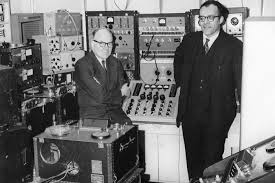Otto Luening / Vladimir Ussachevsky – Tape Recorder Music
Release: 1955
Label: Gene Bruck Enterprises Inc.
I only discovered this album recently, and I am simply astounded that it was recorded as far back as 1955. I love strange cut ups such as those one might hear from Prefuse 73 and all sorts of strnage ambient music appeals to me so to discover that these two people who I have never heard of were doing the same thing on what can be considered to be primative equipment 65 years ago is fantastic, and it reminds me just how much music there is still out there just waiting to be discovered.

I haven’t been able to find much information about this project but what I do know is that American composer, conductor, composition teacher, and flutist Otto Luening and fellow composer Vladimir Ussachevsky helped to establish the Columbia-Princeton Electronic Music Center in the 1950’s where they created on a landmark series of collaborative compositions for magnetic tape and synthesizer, as well as works for acoustic instruments in combination with electronic sounds.
The music they created, “tape music,” was a uniquely American synthesis of the French musique concrète and the German pure electronic schools. It is a revelation to me.
Tracklist
Sonic Contours
Fantasy In Space
Incantation Luening
Invention
Low Speed
Here are ten interesting facts about Otto Luening / Vladimir Ussachevsky – Tape Recorder Music, a pioneering work in electronic music:
- Early Electronic Experimentation – This album, released in 1955, is one of the earliest collections of electronic tape music in the United States, showcasing groundbreaking experiments in sound manipulation.
- Columbia-Princeton Electronic Music Center – Luening and Ussachevsky were key figures in founding the Columbia-Princeton Electronic Music Center, a leading hub for early electronic composition.
- Use of Magnetic Tape – The compositions relied on manipulating recorded sounds using tape recorders, a novel technique at the time. They sped up, slowed down, reversed, and layered sounds to create unique textures.
- Flute and Electronics Fusion – Luening, a flutist, incorporated recordings of his flute playing into electronic compositions, transforming its sound through tape manipulation.
- Live Performances with Tape – Unlike purely synthesized music, some works from the album were performed live with pre-recorded tape, a concept that influenced later electronic and experimental performances.
- Influence on Later Composers – The techniques developed by Luening and Ussachevsky influenced avant-garde and electronic composers like Milton Babbitt, Karlheinz Stockhausen, and later, minimalists like Steve Reich.
- Debut at the Museum of Modern Art – Some of the works on the album were first presented at MoMA in 1952, marking one of the earliest public performances of tape music in the U.S.
- Collaboration with RCA – Their work was partly supported by RCA, which had developed early synthesizers and tape technology, helping them experiment with cutting-edge electronic sound production.
- Expansion of Academic Electronic Music – This album played a role in legitimizing electronic music as an academic discipline, influencing the establishment of electronic music programs in universities.
- Legacy in Electronic and Film Music – Their pioneering use of tape techniques laid the groundwork for later developments in film scores, electronic music, and ambient sound design.


Leave a Reply